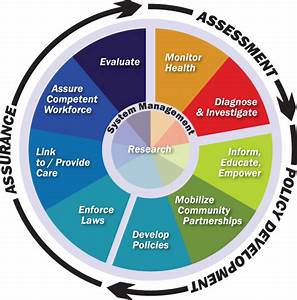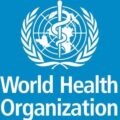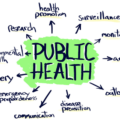What is a Public Health System?
Public health systems are commonly defined as “all public, private, and voluntary entities that contribute to the delivery of essential public health services within a jurisdiction.” This concept ensures that all entities’ contributions to the health and well-being of the community or state are recognized in assessing the provision of public health services.
The public health system includes
- Public health agencies at state and local levels
- Healthcare providers
- Public safety agencies
- Human service and charity organizations
- Education and youth development organizations
- Recreation and arts-related organizations
- Economic and philanthropic organizations
- Environmental agencies and organizations
The 10 Essential Public Health Services
Essential services are then linked to the 3 core functions of public health: assessment, policy development, and assurance. The 10 Essential Public Health Services describe the public health activities that all communities should undertake and serve as the framework for the NPHPS instruments. Public health systems should:
- Monitor health status to identify and solve community health problems.
- Diagnose and investigate health problems and health hazards in the community.
- Inform, educate, and empower people about health issues.
- Mobilize community partnerships and action to identify and solve health problems.
- Develop public health policies and plans that support individual and community health efforts.
- Enforce laws and regulations that protect health and ensure safety.
- Link people to needed personal health services and assure the provision of health care when otherwise unavailable.
- Assure competent public and personal health care workforce.
- Evaluate effectiveness, accessibility, and quality of personal and population-based health services.
- Research for new insights and innovative solutions to health problems. See: Top 20 Public Health Journal
Philosophy of Public Health
Public health is concerned with promoting and protecting the health of populations. Public health action occurs at the international, national, state, and local level. Most communities are served by health departments whose services include the collection and use of epidemiological data with the help of health apps for Android and iOS for population surveillance of disease. Health promotion and the protection of population health occurs at the global level, World Health Organization (WHO), and at the national level under the Centers for Disease Control and Prevention, the Food and Drug Administration, the Environmental Protection Agency, and Consumer Protection Agency as public health agencies.
Moral foundations and justifications for public health and the challenges faced due to limited resources are the ethical issues debated that view public health as social justice, poverty, and health disparity concern. Public health policy seeks to balance the greater health outcomes with individual liberties, for example, the immunization debate. Public health has two primary aims, prevention, and health promotion.
Prevention: Prevention is the action taken to prevent the occurrence of an event or to minimize its effects after it has occurred. Three levels of prevention are described as
- primary prevention – aimed at reducing risk, such as immunization
- secondary prevention- aimed at detecting and treating the disease at early stages, such as screenings (mammograms)
- tertiary prevention – treatment aimed at modifying risk factors of disease, such as cardiac rehabilitation
Health promotion refers to strategies that seek to eliminate or reduce exposures to risk factors of disease by modifying human behaviors.
- Incidence –Number of new cases that develop of a particular disease/injury
- Prevalence –Proportion of people who have the disease at a specific point in time
- Morbidity –The relative incidence of a particular disease
- Mortality –The number of deaths that occur at a specific time, in a specific group, or from a specific cause
- Birth rate –Number of live births per one thousand women
- Fertility rate –Number of live births per one thousand women between fifteen
and forty-four years of age, generally considered a woman’s prime childbearing years
- Infant Mortality –Number of live-born infants who die before their first birthday per one thousand live births
- Life expectancy –Number of additional years of life expected at a specific point in time, such as at birth or at age 45
- Epidemiology –Study of distribution and causes of health-related states or events in populations
–Application of the study to control health
- Epidemiology –Study of distribution and causes of health-related states or events in populations
- Surveillance –Systematic collection, analysis, interpretation, and dissemination of health data on an ongoing basis
- Epidemic –Occurrence of more cases of disease than expected in a given area or among a specific group of people over a particular period of time
- Pandemic –Epidemic occurring in a wide geographical area and usually affecting a large part of population
- Endemic –Constant presence of a disease or infection within a geographic area or population group.
SEE: The Components Of Primary Health Care
Levels of Public Health
Three general levels of public health – local, state, federal
Most – but not all – states are associated with a network of local or county health departments
Public health infrastructure provides communities, states, and the Nation the capacity to prevent disease, promote health, and prepare for and respond to both acute (emergency) threats and chronic (ongoing) challenges to health. Infrastructure is the foundation for planning, delivering, evaluating, and improving public health. All public health services depend on the presence of basic infrastructure. Every public health program—such as immunizations, infectious disease monitoring, cancer, and asthma prevention, drinking water quality, injury prevention—requires health professionals who are competent in cross-cutting and technical skills, up-to-date information systems, and public health organizations with the capacity to assess and respond to community health needs. While a strong infrastructure depends on many organizations, public health agencies (health departments) are considered primary players. Federal agencies rely on the presence of solid public health infrastructure at all levels to support the implementation of public health programs and policies and to respond to health threats, including those from other countries.
Public health infrastructure can best be described by what it is and what it does. It includes three key components:
- A capable and qualified workforce
- Up-to-date data and information systems
- Agencies capable of assessing and responding to public health needs
Public health infrastructure provides the necessary foundation for undertaking the basic responsibilities of public health, which have been defined as the 10 Essential Public Health Services
FEDERAL PH RESPONSIBILITIES
Public health data must be accurate, relevant, and timely to inform public health action. National surveys, such as those sent to epidemiologists, laboratories, and health departments, play an important role in understanding the public health infrastructure. National surveillance and reporting systems also play a vital role. Efforts are underway to improve the content of surveys, data collection for major population groups, and timely access to data through public reports and data files. These national surveys and monitoring systems should be sustained, strengthened, and harmonized.
Continuing to strengthen the evidence base for effective community interventions and for the effective organization, administration, and financing of public health services is critical to the future development of public health infrastructure. Public health surveillance, services, and systems research play an important role in the development of this evidence base; support should be expanded over the decade, with a strong focus on translating research into practice. SEE: What Is Behavior Modification?
Progress in Public Health
Public health in the US works in the public interest. Consider the positive impact in daily life attributed to public health policy and action: food safety/restaurant inspections, fluoridated water, seatbelt use, unleaded gasoline, influenza vaccine programs, trans-fats and other nutritional information, public health response to the most recent disaster.
- Since 1900, the average life expectancy for Americans has increased about 30 years; 25 of those years are attributed to public health initiatives
- 1950 – in anti-tuberculosis efforts, more than 2 million X-ray examinations were made by the Public Health Service
- 1977 – Worldwide eradication of smallpox (as recently as 1958, two million people a year die from smallpox)
- 1990’s – only 4.4% of US children have elevated blood lead levels (in the 1970’s, 88.2% had elevated blood lead levels)
- A combination of medical progress and public health efforts have nearly eliminated deaths from previously-rampant childhood diseases such as:
- Measles
- Diphtheria
- Scarlet fever
- Whooping cough
In recent years, a series of different public health threats emphasized the context of public health in the US. These events required responses from more than one geographic area and more than one agency.
- Hurricane Sandy: hit the US in October 2012; was the largest Atlantic hurricane on record; approx. $71 Billion in damages; affected 24 states, but most severe damage in New Jersey and New York, with seawater flooding streets, tunnels, and subway lines.
- Salmonella contamination of peanut butter: in 2011, the US Food and Drug Administration (FDA), the CDC, and state and local public health officials investigated a multistate (20) outbreak of salmonella infections linked to peanut butter, of special concern because many children eat peanut butter. The collaborative work identified the origin and shut it down quickly. (Source: FDA)
- H1N1 Epidemic: the H1N1 flu virus caused a worldwide pandemic in 2009 as a new strain of swine-origin. It caused about 17,000 deaths by the start of 2010.
- Hurricane Katrina in 2005
- 9/11 attacks on the US in 2001
- The second-strongest hurricane ever recorded in the United States, covered most of the Gulf of Mexico
- Most deaths occurred in New Orleans, Louisiana, which flooded as the levee system catastrophically failed. Eventually, 80% of the city and neighboring parishes became flooded, and the floodwaters lingered for weeks.
- The worst property damage occurred in coastal areas, such as all the beachfront towns in Mississippi, which were flooded over 90% within hours, with waters reaching 6–12 miles inland (10–19 kilometers) from the beach.
- Due to these events, much federal funding and focus was placed on preparedness and emergency response.
- However, state and local health departments are still responsible for addressing those population-based health issues in their communities.
- Two planes crashed into the north and south towers of the World Trade Center in New York.
- A third plane crashed into the Pentagon in Washington DC (the headquarters of the US Department of Defense).
- The fourth plane crashed into a field in Pennsylvania after the passengers tried to overcome the hijackers. It had originally targeted the US Capitol in Washington DC.
- Over 3,000 people were killed during the attacks in New York City and Washington, DC, including more than 400 police officers and firefighters.
- The attacks fundamentally changed the attitude toward terrorist attacks in the US and prompted increased planning and funding for preparedness.
SEE: Equity Vs Equality: Understanding The Difference
Vaccination—There are now 50,000 fewer cases of smallpox than occurred in 1900; 900,000 fewer cases of measles than occurred in 1941; 21,000 fewer cases of polio than occurred in 1951. Programs of population-wide vaccinations resulted in the eradication of smallpox; elimination of polio in the Americas; and control of measles, rubella, tetanus, and diphtheria in the US and other parts of the world.
Motor vehicle safety—Since 1925, the annual death rate from motor vehicle travel has decreased 90%. Seat belts have saved approximately 85,000 lives; child safety seats have reduced the risk of infant death by 69%. Community awareness and DWI (driving while intoxicated) regulations have helped reduce alcohol-related deaths by 32%.
Control of infectious diseases—Infections (such as typhoid and cholera), major causes of illness and death early in the 20th century, have been reduced dramatically by improved sanitation. Also, the discovery of antimicrobial therapy has been critical to successful public health efforts to control infections such as tuberculosis and sexually transmitted diseases.
The decline in deaths from coronary heart disease and stroke—Deaths from coronary heart disease and stroke have declined due to risk-factor modification, such as smoking cessation and blood pressure control. Since 1972, death rates for coronary heart disease have decreased 51%.
Recognition of tobacco use as a health hazard—Recognition of tobacco use as a health hazard in 1964 resulted in reduced use and reduced exposure to secondhand tobacco smoke.
Healthier mothers and babies—Healthier mothers and babies are a result of better hygiene and nutrition, antibiotics, access to health care, technology in maternal and neonatal medicine, and immunizations. Since 1900, infant mortality has decreased more than 90%, and maternal mortality has decreased 99%. SEE: The 10 Qualities Of A Good Public Health Leader






